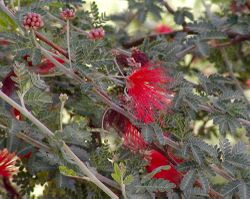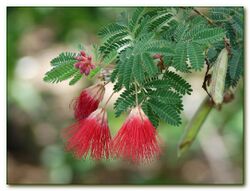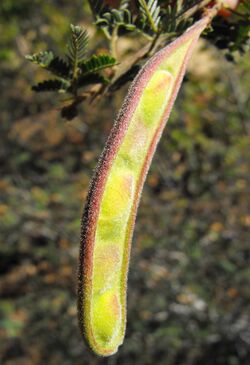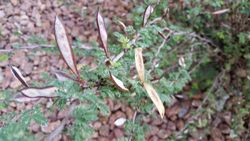Biology:Calliandra californica
| Calliandra californica | |
|---|---|

| |
| Scientific classification | |
| Kingdom: | Plantae |
| Clade: | Tracheophytes |
| Clade: | Angiosperms |
| Clade: | Eudicots |
| Clade: | Rosids |
| Order: | Fabales |
| Family: | Fabaceae |
| Subfamily: | Caesalpinioideae |
| Clade: | Mimosoid clade |
| Genus: | Calliandra |
| Species: | C. californica
|
| Binomial name | |
| Calliandra californica Benth.
| |
| Synonyms[1] | |
| |
Calliandra californica, the Baja fairy duster, is an evergreen, woody shrub, native to Baja California, Mexico. In Spanish, the plant is also known vernacularly as tabardillo, zapotillo[2] or chuparosa.[3] The flowers, which appear in early summer, have clusters of red stamens. The shrub is usually 0.6–1.8 metres (2 ft 0 in–5 ft 11 in) in height and has bipinnate leaves. The leaves have been described as "fern-like."[4] Leaves close at night time.[5]
Calliandra californica is cold tolerant to temperatures of 22 °F (−6 °C),[5] though its roots will tolerate temperatures as low as 5 °F (−15 °C).[6] It grows best in full sun.[5] C. californica is very drought tolerant, needing only 10 inches (250 mm) of water every year.[6] However, additional watering will encourage C. californica to bloom through summer and again in the fall.[6]
Propagation of C. californica is done through "acid scarification" or vegetative cutting.[5] Seed pods from this plant look like "snow peas" and when ripe, they explode.[4] The pods are flat and about 2 inches (51 mm) long.[6] After ejecting seeds, the curled open pods remain attached to the plant for some time.[7]
Calliandra californica attracts both bees and hummingbirds.[5]
Along with many other legumes and leadworts (Plumbago),[8] it is a host plant for the Marine Blue caterpillar (Leptotes marina).[9]
In landscaping, it is suggested that C. californica is used in borders or foreground plantings, as an island accent or even in containers.[6]
References
- ↑ The Plant List: A Working List of All Plant Species, http://www.theplantlist.org/tpl1.1/record/ild-11376, retrieved 19 June 2016
- ↑ {{citation | mode = cs1 | title = Calliandra californica | work = Germplasm Resources Information Network (GRIN) | url = | publisher = [[Organization:Agricultural Research ServAgricultural Research Service (ARS), United States Department of Agriculture (USDA) | access-date = 7 May 2015 }}
- ↑ "Calliandra californica". Legume Web. 1 November 2005. http://www.ildis.org/LegumeWeb?sciname=Calliandra+californica.
- ↑ 4.0 4.1 Meyer, Chris; Meyer, Trish. "Calliandra californica: Baja Fairy Duster". Sherman Oaks Garden. http://www.wildscaping.com/plants/plantprofiles/Calliandra_californica.htm.
- ↑ 5.0 5.1 5.2 5.3 5.4 "Calliandra californica". http://www.public.asu.edu/~camartin/plants/Plant%20html%20files/calliandracalifornica.html.
- ↑ 6.0 6.1 6.2 6.3 6.4 Miller, George Oxford (2008). Landscaping with Native Plants of Southern California. Voyageur Press. pp. 91. ISBN 9781616739492.
- ↑ "Baja Fairy Duster". Virginia Tech. http://dendro.cnre.vt.edu/dendrology/syllabus/factsheet.cfm?ID=949.
- ↑ "Marine Blue". Butterflies and Moths of North America. http://www.butterfliesandmoths.org/species?l=1583.
- ↑ Rich Bailowitz and Jim Brock. "Southeastern Arizona". North American Butterfly Association. http://www.naba.org/ftp/seaz.pdf.
Further reading
Wikidata ☰ Q164408 entry
 |




